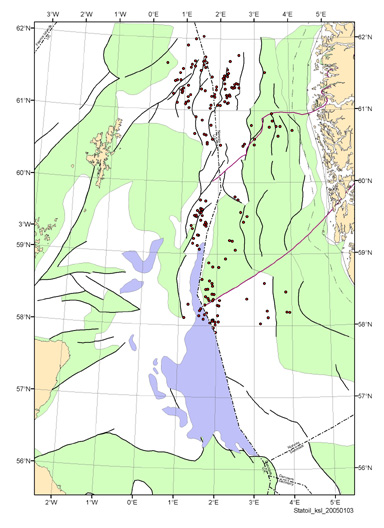Lunde Formation
(See also NPD Bulletin no. 3 for previous
definition)
Hegre Group
Name
Named after the bird Puffin (Norwegian: lunde).
Well type section
Norwegian well 33/12-2
from 2951 m to 3749 m, coordinates N61°13'31.38", E01°51'25.97".
Well reference sections
UK well 211/29-5 from 3003 m to 3795 m, coordinates N 61°04'43.00",
E01°45'46.5o".
NO well 34/4-C-6H from 2980 m to 3452 m, coordinates N 61°31'30.51",
E02°12'40.66".
NO well 34/7-3
from 2635 m to 3365 m, coordinates N 61°25'54.05", E 02°07'43.95".
Thickness
798 m in the type well and 792 m in the reference well.
Lithology
The succession of the Lunde Formation is dominated by very fine to very
coarse-grained sandstones, claystones, mudstones, shales and marls. The
sandstones are mainly white while the fine grained lithologies are
generally red, green and grey-green. This is contrasting to the pre- Alke
Formation succession where all lithologies generally are red stained.
Especially in the upper part of the succession the claystones and
mudstones are non-stained.
Boundaries
The base of the Formation is picked at the transition from the fine
grained lithology of the Alke Formation to the
intercalated sandstones and
mudstones/claystones of the Lunde Formation. This transition is marked by
a distinct change in the sonic and gamma ray logs.
Distribution

Distribution of the Lunde Formation (click image for full size).
The distribution of the Lunde Formation of this figure is north of 60
degrees.
Occurrences of formation tops in wells
Age
Late Triassic, Norian to Early Rhaetian.
Depositional environment
The Lunde Formation represents a major depositional fluvial system
building out from the Fennoscandian Shield, or/and from the East Shetland
Platform.
Comments
The base boundary of the Lunde Formation has been changed from its
original definition. It was at the time of original definition discussed
that the lower unit of the Formation should be erected and defined as a
separate unit at a later stage (Vollset & Doré 1984). As the lower
boundary has been changed, the Formation should have been abandoned and
new name erected. Salvador (1994), states, however, that units which have
been in extensive use, can keep its original name although the boundaries
of the formation is changed. Nystuen (1989) states that minor changes in
definition of boundaries may be desirable following new investigations. If
such revision only alters a small portion of the original unit, its name
can be retained. As the Lunde Formation is an important reservoir in the
Snorre Field and has been extensive used, as well as it was already
mentioned upon definition that the lower boundary of the Formation should
be modified, it is here chosen not to abandon the Formation, but rather
adjust the lower boundary. It is mainly the upper part of the Lunde
Formation which has been dealt with as reservoir within the Snorre Field,
and it will therefore only to a minor degree affect its use.


